1.National Treasure of China and a Living Fossil
The giant panda has lived on earth for at least 2 million years, which makes it a living fossil for ancient animal studies. The panda is also a national treasure of China, the Ambassador of the World Wildlife Fund (WWF), and the flagship species for the protection of world biodiversity.
2.Not an Endangered Species Anymore
In 2016, the International Union for Conservation of Nature (IUCN) declared that the panda is not an endangered species anymore owing to the outstanding work of the Chinese government.
3.Not Original Bamboo-eater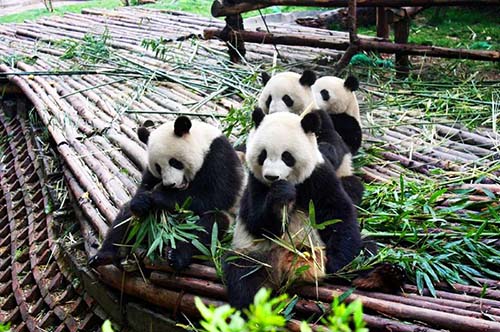
Pandas belong to Chiroptera and their preferred food used to be meat only. Pandas evolved their diet under pressure from the environmental changes. About 1.8 million years ago, the climate changed drastically and most of the carnivores were on verge of extinction. Pandas moved to the mountains in Sichuan and Gansu where bamboo plants were abundant. To survive, the pandas gradually got used to eating these fibers.
4.Not Good at Digesting Bamboo
One may assume that the panda must have a gut that can digest its only food source. The truth is while the panda now has the habit of eating bamboo like a herbivore, the panda still has a carnivore’s digestive system. The latest study shows that panda lacks the gut flora that helps to extract the most energy from the bamboo. Its stomach is quite simple and the intestine is short which is quite different from that of a herbivore cow.
5.Truth: Pandas Don’t Like Bamboos
The giant pandas may seem to be herbivores, but inside their body, it’s definitely carnivore. They eat bamboo to survive but not because they like them. In fact, pandas will prefer meat if allowed. Wild pandas even prey small animals.
6.Bamboo is Like Fake Meat to Pandas
Pandas rely on the new shoots coming out of bamboos, which contain 32% protein. Pandas switched to acquire proteins from these shoots instead of actual meat, just like human vegetarians have tofu and beans for protein. To pandas a certain part of the bamboo is just like meat.
7.Different Bamboo Parts at Different Times
When giant pandas were forced to live in the Qinling mountain area,  there were only the wood bamboos and arrow bamboos available. The wood and arrow bamboos grow in different elevations and sprout new shoots and leaves at different times of the year. Pandas had to switch between those areas to forage sprouts. The pandas fed themselves on the wood bamboo shoots in spring when they are widely available. In June, these wood bamboo shoots grow mature and nutrients are insufficient. Therefore, the pandas moved to higher elevations and ate arrow bamboo shoots. As nutritious as the bamboo shoots are, they have low calcium levels, which drives pandas to consume calcium-rich bamboo leaves in later July after which the pandas would migrate to a lower elevation to search wood bamboo shoots again.
there were only the wood bamboos and arrow bamboos available. The wood and arrow bamboos grow in different elevations and sprout new shoots and leaves at different times of the year. Pandas had to switch between those areas to forage sprouts. The pandas fed themselves on the wood bamboo shoots in spring when they are widely available. In June, these wood bamboo shoots grow mature and nutrients are insufficient. Therefore, the pandas moved to higher elevations and ate arrow bamboo shoots. As nutritious as the bamboo shoots are, they have low calcium levels, which drives pandas to consume calcium-rich bamboo leaves in later July after which the pandas would migrate to a lower elevation to search wood bamboo shoots again.
8.A Dangerous Animal
As cute as giant pandas may seem to be, they are actually as dangerous as other bear species when enraged. The pandas have allegedly eaten iron, which resulted in the name “Shitieshou” (the animal that eats iron). Statistically, pandas have huge muscles on their jaws to crush prey with an incredible amount of force, 1,298 pounds to be exact, which is even more than the black bear and just a little less than a polar bear. Pandas have a pretty impressive running speed that can exceed Liu Xiang (the No.1 running athlete in China). 3-4 wolves are just like toys for panda play.
9.Native Animal in China
Panda is an endemic species in China, mainly inhabiting the mountains of Sichuan, Shaanxi and Gansu Province. In primitive times, there were pandas living in other areas outside China too. With the earth becoming cold, many were killed, but Qinling Mountain and Daba Mountain running east to west blocked the cold current, creating a warm and moist environment for pandas to survive.
10.“Giant” Pandas
Pandas may seem to be small and cute, but in fact, a grown wild panda can be 60-70 kg, sometimes even 110 kg, while the captive grown panda may weigh 80-125 kg, with 181.5kg to be recorded as the largest. The average body length of a wild panda can be 1.2-1.5m, while the captive ones can be 1.8m.
11.Pandas are Big Eaters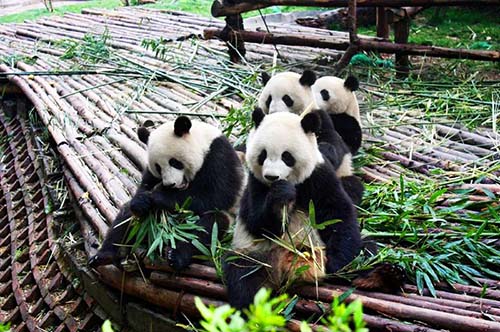
In the wild, eating takes up to 14 hours in pandas’ day time. A grown panda consumes about 12-38 kg of food per day, which is about 40% of their body weight. They have to eat constantly to get the nutrition their bodies need.
12.Pandas Poop 28 kg/day
A panda has a short intestine and it’s hard for it to fully digest the food it eats. Most of the bamboos a panda has eaten go straight out the other end. This is also why a panda has to eat constantly and poop commensurately. A panda can poop about 40 times a day and the waste can be up to 28kg. Like little babies, pandas can eat and poop at the same time!
13.Longevity of 30 Years
The average life span of a panda is 18-20 years in the wild, while captive ones may live more than 30 years. There is one captive panda in Wuhan Zoo who has lived for 37 years, creating a new world record.
14.Reproduction
In the wild, the female adult panda tends to choose the male panda that wins her over. Monogamy is not a thing with pandas. One male can mate with different females and vice versa. A grown panda reaches its sexual maturity at 5.5-6.5 years old. The mating season is usually in Spring, March to May, for about 2-4 days. In this short period of time, the female panda only has 2 days in estrus and ovulates once a year. The male and female pandas associate for 2-4 days.
Once the female panda is impregnated, the gestation takes about 95-160 days. Normally, the mother panda can only deliver one cub, but for pandas in captivity, twins are very possible. The female panda can reproduce every 2 years.
15.Features about Panda Cubs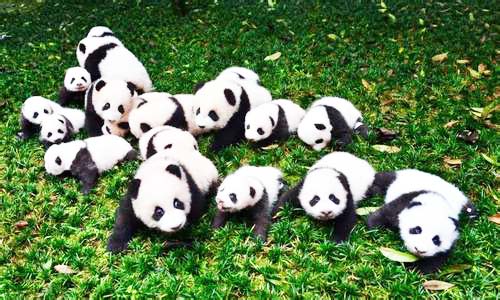
The newborn panda cubs weigh only 3-5 oz, about the size of a stick of butter. Panda babies are the world’s smallest baby mammals. They are completely blind and their eyes only open after about 60-80 days. Their bodies are pink, with just a layer of barely-visible hair. In the first 3 months, they are under the most critical phase and entirely dependent on outside help. The mother pandas need to lick the cubs’ rear-end to stimulate their desire of urination and defecation. Human care is in great need if the mother bear can’t perform the task very well.
Growth and development of panda cub
At birth, the baby cubs are just about 1/900 weight of their mothers' and are very tiny, pink, and crying constantly with eyes shut tightly.
Several weeks later, these little cuties sleep and suckle all the time just like a human baby. During this time, the black hair will appear gradually.
In 1-2 months, the cubs grow like miniatures of their parents, and the vocalization becomes less and less. Their eyes began to open, but not entirely.
After about 70-80 days, teeth begin to erupt and the cubs' eyesight improves dramatically. It can even try several steps and climb to their mothers’ back and play.
During 5 months to one year old, the cubs begin to simulate their mothers. They have 26-28 teeth, which enable them to have solids. By the age of one year, the cubs will have permanent teeth and their weights will be between 50-60 pounds.
By 1.5 years old, the cubs leave their mothers and live by themselves.
16.Mama Panda Takes Care of Its Cub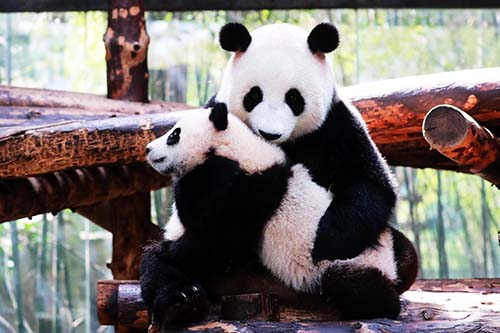
The mama panda is known for being very careful and protective. This is understandable considering how tiny the newborn is. The mama bear carries her cub very gently in her mouth if she has to move around. When she sits, she holds the baby on her big paw. She never wants to put her baby down for bamboo until her baby is around 3-4 weeks. By then, the cub can regulate its body temperature and the constant contact with its mother for warmth is no longer necessary.
As one mama panda can only take care of one baby at a time, things can be a bit difficult if she has twins. The mama panda abandons the weaker one and focuses on the stronger baby. In the wild, the weaker cub’s destiny is doomed. While in the zoo, the zookeeper jumps in and play the role of mother bear.
17.Baby Pandas Can Have Dog Milk
In the case of a milk shortage, dog milk can be a replacement! When panda Lele in the Beijing Zoo gave birth to twins, she couldn’t produce enough milk for both cubs. She just focused on one cub and let the zookeeper take care of the other. The similar milk of dogs made a huge difference!
18.Pandas’ Senses
Pandas have very large olfactory regions in their brains. They can sense what’s happening with pandas up to several miles away by using their sense of smell. A panda's padded paws and tail are seemingly designed as "brushes for spreading its scent."
Spectrometer analysis of pandas’ scents shows that they have a very complex chemical combination that gives off a number of messages such as identity, sex, sexual receptivity and health. Males marking their territory apply a waxy goo to keep the scent alive for months.
19.Sense of Smell
Pandas have a highly developed sense of smell and they communicate through chemical signals: the male through a huge scent gland under the tail; the female through a similar scent gland and chemicals in her urine. Males also use urine-borne signals that they spread by urinating on their paws then rubbing their ears and rubbing vegetation.
20.Pandas Mark Their Territories with Scent Marks
Like many mammals, pandas mark their territories by leaving scent marks. This can serve as a major communication form so other pandas can judge if the one who left the mark is still around, how long before it left the mark, and most importantly, if it is a male or a female in the reproductive period.
To mark the scent, the panda backs up to a tree as high as it can stand until it’s virtually upside down, allowing it to spread its scent in a larger area of the tree. It also rubs its scent glands on the tree, making it last longer. It is quite smart about it usually choosing the widest tree possible with rough bark and moss which retains the scent on the tree.
Besides urination, pandas also secrete anogenital gland secretions, which can indicate its age and gender.
21.Vocal Communication Among Pandas
Pandas don’t just use the scent to communicate, they also use vocalizations. Studies have found various sounds that pandas make to express different meanings. When a male panda is courting a mate, he will say “neeeeh” like a sheep, while the female responds with a chirp or twitter like a bird’s sound to indicate that she is keen. The chirp or twitter will go higher if the female is in great heat. Before and during the sexual encounter, pandas will sing. When a panda is unhappy, it makes a sound of “wow-wow” and it will turn to “gee-gee”, meaning it’s hungry and wants more food.
22.Panda Appearance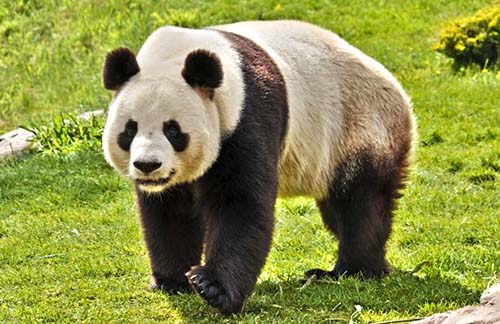
Panda has a unique appearance. It has striking black and white fur thickly covering the whole body, preventing coldness in the mountain. Its head and hindquarters are mostly white, while the arms, front half of the body and the back legs are black.
An adult panda can weigh about 150kg and males are comparably 10% larger and 20% heavier than females. Standing on all fours, a grown-up panda can be 90-120cm tall and up to 180cm long from nose to rump. It has a cute little white tail 10-15cm long. Its chest girth can be 70-106 cm, quite a big creature.
Pandas have strong claws to hold the bamboo steady and sharp teeth to tear it into pieces.
23.Why do Pandas Have Striking Black and White Fur?
Have you ever wondered why the pandas have striking black and white fur? There are several thoughts, but the most reliable one is that such a pattern on the fur is used for camouflage and communication. Researchers have compared pandas’ fur with other animals and they found out that pandas developed white fur to help hide in snowy habitats. While the black marking will be helpful in hiding from their predators, like leopards, in the forest. The current fur pattern seems to be a compromise to help survive through the dark forest and snowy winter. Pandas also have black ears and eye patches to reinforce their ferocity when they encounter predators. In addition, pandas can change the size and shape of their eye patches to warn other animals.
24.The Legend of Black and White Fur
Tibet has a legend about pandas’ unique black and white fur. The story begins when four young shepherdesses die rescuing a panda from a ferociously starving leopard. When the news broke among other pandas, they decided to hold a funeral to commemorate those four brave shepherdesses. Pandas had pure white fur at that time. To show their respect to the dead, pandas wore black arm badges to the funeral. They cried so much that their tears mixed with their black badges. When they wiped away their tears, two big black eye patches appeared. Also, in their grief the pandas hugged each other while crying, creating black patterns on their backs. As time went by, those black marks remained on the pandas bodies and now the cubs have such marks too!
25.Pandas Are Nearsighted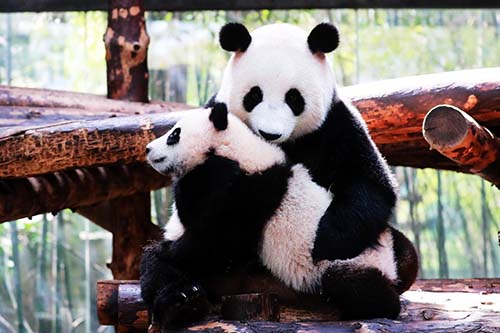
It may be shocking that pandas are myopic considering how large their eye patches are. Well, those are just patches and pandas actually have normal sized eyes. They spend a long time in bamboo thickets and don’t move around much which makes their eyesight poor in seeing far. In fact, they can only see about five feet far away.
26.Pandas Have Better Eyesight at Night
Like many nocturnal animals, pandas have better vision at night than in daytime. Their eyes have pupils with vertical slits which make it easier than round pupils to adjust to light. Pandas also have more rod cells than cone cells which are more suitable for night.
27.Pandas Have Opposable Thumbs
Like their kin bears, pandas have paws. What’s different is that pandas have an “opposable thumb”. This extra thumb really confused zoologists. The truth is that this “thumb” is not much of a true thumb, but the adjacent digit. A normal digit has 3-4 bones while this “digit” has only one bone which is actually the protruding end of the panda’s wrist bone to help them better grasp bamboo. It’s the result of natural evolution.
28.Molting
The thick and dense pelt on giant pandas protect against the cold weather. However, each season needs different amount of insulation; therefore, a different amount of fur. In general, mammals molt to adapt to the change in seasonal temperatures. In late summer and autumn, they grow extra fur to be prepared for winter. While in the late spring, they begin to shed excess fur and be cool.
The problem is that giant pandas have a rigid diet and they can’t perform a seasonal molt without losing energy. Therefore, pandas adopt a strategy of continuous molt, taking their time to molt steadily in a smaller proportion.
29.Pandas are Good Tree Climbers and Swimmers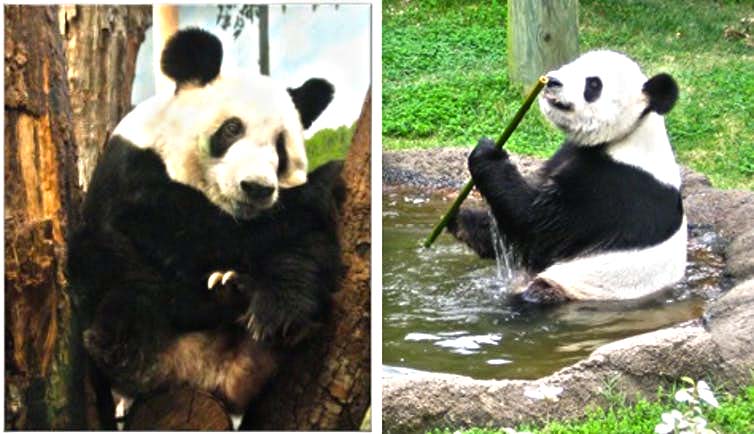
As clumsy as pandas may seem, they are actually excellent tree climbers and swimmers. Pandas are born with soft fingernails that become thick, hard and long as the pandas age. Pandas dig their nails into tree trunks while climbing. In fact, pandas love to climb trees and can even climb from one tree to another. Pandas can also swim and are quite good at it although they don’t spend a lot of time in the water.
30.Pandas don’t Like to Confront
Pandas don’t like to confront other animals. They are one of few animals that fear predators. The thick bamboo thickets provide good protection for them and they can easily move around. Due to their limited diet they move in a very restrained way to conserve energy. Pandas make a beeline to the nearest tree when confronted by other animals.
31.Winter is Hard for Pandas Too
Winter can be fairly hard for people and for pandas. In the cold winter, bamboo leaves age and the nutrients drop dramatically causing mortality and sickness among pandas. Over half of the wild pandas may not survive the winter.
32.No Hibernation
Unlike other bears, pandas don’t hibernate in winter. The main reason is that pandas can’t restore fat and they need to search for bamboo every day. During winter, pandas will go to lower altitudes in the mountains where bamboo is still thriving and it’s not too cold. The hollow trees and rock crevices are be good shelters for pandas on stormy days.
33.Mystery: Solitary or Not?
Pandas have been referred to as solitary and secretive. Due to the limitation of their diet, they have to stay in one place at a time and eat their way out. They spend most of their day eating and pooping, leaving little time for socializing. The fact is that they desire social life just as other mammals do. Some researchers tracked five wild pandas in Wolong Nature Reserve from 2010-2012 and found that they actually like to hang out with each other. Three pandas were found to be in the same area and stayed together for several weeks in autumn outside the mating season.
34.Panda Population
By the last census, there are 1864 wild pandas and 548 pandas in captivity. In the 1990s, the survival rate for captive-born cubs was just 30%. It has grown to 93% by 2018. In fact, 45 of the 48 pandas born in 2018 survived.
35.Symbol of WWF
Giant panda has become the symbol for World Wildlife Fund (WWF) since 1961. But why? The inspiration came from a panda named Chi-Chi, who arrived at the London Zoo in the same year when the WWF was founded. The panda’s uniquely appealing appearance combined with it’s strength captured the founders’ hearts and hence became the logo for WWF. Not to mention that a panda image minimizes the painting cost of a logo.
36.Pandas and Chinese Philosophy of Yin and Yang
Chinese people believe everything on earth is composed of two opposing forces, aka Yin and Yang that keep things in balance. These two forces seem to be in sharp contrast with each also possessing the trait of the other while they are naturally connected. The giant panda is a token of such principle. It has strikingly distinctive black and white markings with black dots sprinkled in the white area, forming a harmonious look, resembling the Chinese philosophy of Yin and Yang, and bringing a sense of natural ease to eyes and mind.
37.Panda as National Treasure of China
Why is the panda considered the National Treasure of China while there are so many other animals available in China? The following six points can offer you a full explanation.
I.The giant panda has lived on earth for about 8 million years. It represents the longevity of China going up and down in a long history.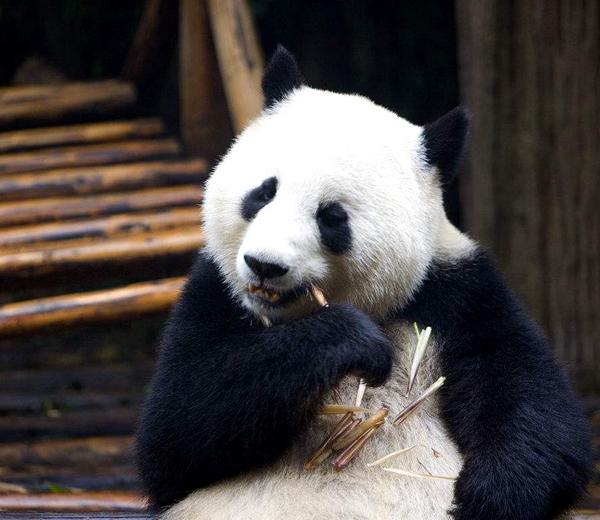 II.As one of the animal species on the verge of extinction, pandas are rare and valuable.
III.People adore them for their round face, big black eye sockets, and plump body. It’s quite interesting to watch pandas walk with their feet turned in like a “八”.
IV.Pandas have black and white fur that coincides with the traditional Taoist Chinese philosophy of Yin and Yang.
V. Pandas are gentle and mild. They don’t usually attack other animals or people. Even if there is an encounter, they avoid it.
VI.Pandas out-survived many of their kin. They may seem harmless on first impression; but actually, they have sharp claws and can attack fiercely if necessary. China is a country that values peace and is dedicated to bringing peace everywhere. It is strong and powerful, but it’s more likely to show respect and offer friendship first.
II.As one of the animal species on the verge of extinction, pandas are rare and valuable.
III.People adore them for their round face, big black eye sockets, and plump body. It’s quite interesting to watch pandas walk with their feet turned in like a “八”.
IV.Pandas have black and white fur that coincides with the traditional Taoist Chinese philosophy of Yin and Yang.
V. Pandas are gentle and mild. They don’t usually attack other animals or people. Even if there is an encounter, they avoid it.
VI.Pandas out-survived many of their kin. They may seem harmless on first impression; but actually, they have sharp claws and can attack fiercely if necessary. China is a country that values peace and is dedicated to bringing peace everywhere. It is strong and powerful, but it’s more likely to show respect and offer friendship first.
38.Panda Diplomacy
Aside from being a national treasure, pandas also play a significant role in China’s foreign policy. The panda is frequently used as an unofficial mascot and they are loaned to other nations to enhance the friendship and trust between countries. In fact, panda diplomacy has a rather long history starting from the 1950s. However, one of the most famous moments of panda diplomacy is when China gifted two pandas, Ling Ling and Hsing Hsing, to the United States in 1972, which caused quite a sensation. Since then, panda diplomacy has been practiced frequently. Nowadays, pandas are generally loaned to other countries at a staggering annual amount of 1 million USD. If by any chance, a cub is born on foreign soil, China also charges 400,000 USD. Besides the annual income to China, the host countries have pay to house, feed, and care for the pandas. Given that panda raising is such a demanding job, China only loans pandas to its major trade partners or comparably better-off nations. The latest figures from Chengdu Panda Breeding Center revealed that there are 58 pandas currently on loan to 17 countries.
39.Qizai - the Only Brown Panda in Captivity
When we think of giant pandas, a striking black and white furry thing always come to mind.  However, it’s not always the case. Since 1985, there are 10 brown pandas spotted in Qinling mountain area, but right now there is only one rescued from wild - Qizai. It currently lives at the Foping Panda Valley in Shaanxi Province.
In 2009, Qizai (aka Qinling Panda) was found abandoned by his mother at Qinling Mountain when he was about two months. He was bullied by other black and white pandas and got very weak and ill. Luckily, researchers found him and a new enclosure was established just for him. According to his keeper, Qizai is just as cute as others and he eats bamboo just as much as black and white pandas. The only difference is that he’s somewhat slower than other pandas, which is probably the reason why he was bullied in the first place. In 2018, he was nine years old and he was put into the breeding program in hopes that researchers can learn the reason why he is different.
However, it’s not always the case. Since 1985, there are 10 brown pandas spotted in Qinling mountain area, but right now there is only one rescued from wild - Qizai. It currently lives at the Foping Panda Valley in Shaanxi Province.
In 2009, Qizai (aka Qinling Panda) was found abandoned by his mother at Qinling Mountain when he was about two months. He was bullied by other black and white pandas and got very weak and ill. Luckily, researchers found him and a new enclosure was established just for him. According to his keeper, Qizai is just as cute as others and he eats bamboo just as much as black and white pandas. The only difference is that he’s somewhat slower than other pandas, which is probably the reason why he was bullied in the first place. In 2018, he was nine years old and he was put into the breeding program in hopes that researchers can learn the reason why he is different.
40.The Mystery of Qinling Panda
Qinling Mountain pandas’ unique brown coats baffle experts. Experts tend to believe that it’s a genetic recession that caused it. They think that the unique environment in Qinling Mountain has gradually changed the pandas’ genes. In 2018, researchers arranged for a female black and white panda Zhu Zhu to mate with Qizai, expecting to find out if their offspring would be brown as well. However, despite the effort Qizai failed to mate and the mystery remains.
41.2008 Earthquake
On May 12, 2008, a powerful earthquake occurred in Sichuan province causing tens of thousands of deaths. Pandas didn’t escape this nightmare either. In Wolong Panda Reserve, a couple of pandas were injured and about 14 panda houses were severely damaged. Some bamboo forests were buried under dirt and debris causing eating issues for wild pandas. Thanks to an efficient rescue program many pandas were saved and their home was restored.
There are so many interesting facts about giant pandas, a few anecdotes are not enough. If you are interested in this topic, please feel free to leave us a comment or send us some ideas about additional topics.
Recommended Itineraries
7-day Chengdu Relaxing Tour
Panda Keeper Program in Dujiangyan Panda Base
2 Days Chengdu Highlights Tour with Panda
2 Days Classic Chengdu Tour

 there were only the wood bamboos and arrow bamboos available. The wood and arrow bamboos grow in different elevations and sprout new shoots and leaves at different times of the year. Pandas had to switch between those areas to forage sprouts. The pandas fed themselves on the wood bamboo shoots in spring when they are widely available. In June, these wood bamboo shoots grow mature and nutrients are insufficient. Therefore, the pandas moved to higher elevations and ate arrow bamboo shoots. As nutritious as the bamboo shoots are, they have low calcium levels, which drives pandas to consume calcium-rich bamboo leaves in later July after which the pandas would migrate to a lower elevation to search wood bamboo shoots again.
there were only the wood bamboos and arrow bamboos available. The wood and arrow bamboos grow in different elevations and sprout new shoots and leaves at different times of the year. Pandas had to switch between those areas to forage sprouts. The pandas fed themselves on the wood bamboo shoots in spring when they are widely available. In June, these wood bamboo shoots grow mature and nutrients are insufficient. Therefore, the pandas moved to higher elevations and ate arrow bamboo shoots. As nutritious as the bamboo shoots are, they have low calcium levels, which drives pandas to consume calcium-rich bamboo leaves in later July after which the pandas would migrate to a lower elevation to search wood bamboo shoots again.









 However, it’s not always the case. Since 1985, there are 10 brown pandas spotted in Qinling mountain area, but right now there is only one rescued from wild - Qizai. It currently lives at the Foping Panda Valley in Shaanxi Province.
However, it’s not always the case. Since 1985, there are 10 brown pandas spotted in Qinling mountain area, but right now there is only one rescued from wild - Qizai. It currently lives at the Foping Panda Valley in Shaanxi Province.